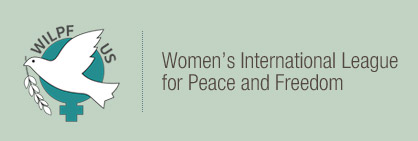Be Involved in Democratizing Our Money!
Published on April, 51 2021
Federal Reserve System symbol on hundred dollar bill / Shutterstock.com.
By Marybeth Gardam
Chair, Women, Money & Democracy Committee
April 2021
Talk to anyone about the Federal Reserve System and watch their eyes glaze over. Tell them we need to dismantle the Fed and democratize our money and they may write you off as a hopeless nutter.
But no, we’re not wearing tin foil hats when we share these ideas! More and more economists are agreeing that our money system is corrupt and built on oppressive debt that keeps us chained. The WILPF US Women, Money & Democracy Committee has been studying these realities and joining with allies on possible solutions.
How the Federal Reserve System Works
Most people believe that the Federal Reserve is a government agency that keeps all the money they print in a vault at Fort Knox, and when we borrow money or our banks do, that money gets somehow transferred to where it’s needed for investment, capital expense spending, or government program expenses (like all that pricey weaponry and unusable nuclear weapons we maintain at a cost of billions each year). It’s what we’ve been told since we were children. My dad worked for the Federal Reserve, and that’s what I thought they did!
Well, the truth is a lot more interesting, and as usual it’s important to ‘follow the money.’ But the money doesn’t lead to Fort Knox like you thought!
The Federal Reserve System is made up of twelve branch banks, the most powerful by far being the New York Federal Reserve. New York is also where all those wolves of Wall Street live and work, and where the New York Stock Exchange rules the economic world. Even though its presidential appointments help it to pose as a government entity, the Fed is independent, owned by the largest and most powerful transnational banks and investment firms. (See also These Are the Banks that Own the New York Fed). Their interest is entirely in profits…theirs, not yours or our government’s.
While your dollar features signatures of the US Treasury Secretary, up top in small print it says: A Federal Reserve Note. So the US Treasury and the US Mint don’t issue ‘our money.’ ‘Our money’ is not stored at Fort Knox. Our money is created by a simple bank credit accounting keystroke that only happens when someone borrows money.
All those student loans, the mortgage on your house, the business loan that kept your employer competitive, or the insurance company that borrows against its policy payments to advertise…all those loans and trillions more create dollars more efficiently than the printers ever could. When you borrow money, it becomes a liability for you, but it is an asset for the financial corporation that made the loan to you. THAT is how the majority of our ‘currency’ comes into existence. No one works for it. But everyone pays for it.
Creative Solutions for Democratizing Our Money
The Alliance for Just Money (AJM) is campaigning hard to reform (“democratize”) our money system and they have some pretty creative ideas about how it might work. Watch a short video called "A Solution to the Crisis - Just Money Now!"
A lot of those ideas are gaining traction with major economists, including Joseph Huber and Michael Kumhof.
The WILPF US Women, Money & Democracy Committee (W$D) has been studying the AJM materials and learning how money really is created out of thin air. The government creates money by borrowing from those ‘too-big-to-fail’ transnational banks, thanks to a law passed in 1913. These are the kind of entangling alliances and pay-to-play dynamics that are at work whenever our government decides to repeatedly bail out those big banks and investment bully boys. But is this really the way we want our government to work? Is it the way we want our money controlled?
If you are interested in learning more about the work of Women, Money & Democracy Committee, contact us to be invited to our monthly Zoom calls. We’re talking about policy and how it affects the lives of women like you and your families. Public banking is one solution we’re working on, but we’re also examining a lot more.
You can view some of the amazing hopeful solutions women are creating to counter the injustice of our current economic system by watching the recordings of the “Zooms of Our Own” webinars that W$D co-sponsors with An Economy of Our Own.
As chair of the W$D committee, I put it this way:
We’re trying to normalize the idea that money doesn’t have to be built on debt, and that money needn’t be scarce or so divisive.
I also want to stress how important these issues are for women. Women are at the heart of economics, but we often get left out of the decisions that most affect our lives and our financial futures. In W$D and working with An Economy of Our Own, we’re learning together how to make sense of it all, and what kinds of reforms could transform the economy into one where the things and values we care most about have real substantive value.



